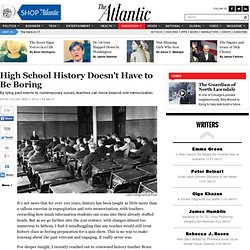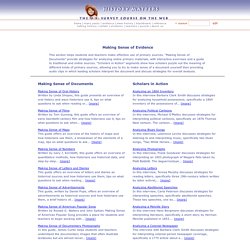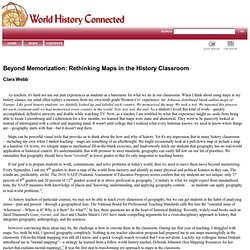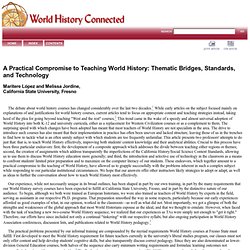

The Gamification of Education Infographic #gamification #edtech. High School History Doesn't Have to Be Boring - David Cutler. By tying past events to contemporary issues, teachers can move beyond rote memorization.

Luther College Archive/Flickr It’s not news that for over 100 years, history has been taught as little more than a callous exercise in regurgitation and rote memorization, with teachers rewarding how much information students can cram into their already stuffed heads. But as we go farther into the 21st century, with changes almost too numerous to fathom, I find it mindboggling that any teacher would still treat history class as boring preparation for a quiz show. This is no way to make learning about the past relevant and engaging. It really never was. “It’s lecture, textbook, and coverage,” Lesh tells me, characterizing the current state of history instruction. In Lesh’s book, Why Won’t You Just Tell Us the Answer?
“I'm not preparing you to go work in the archives,” Lesh says, noting that in his 21 years in the classroom, he’s taught only one student who went on to earn a Ph.D. in history. Department of History. Essays form an integral part of your history courses.

They can also be one of the most rewarding aspects of a course, giving you a chance to research the raw material of history (primary sources) and to analyze other historians' interpretations of the past (secondary sources). Essay writing is an opportunity to develop your research and writing skills. It is ultimately a lesson in communication. No matter how comprehensive your research or how brilliant your ideas, the essay will flounder if it is not well-organized and presented in clear and grammatically correct English. Obviously, good essay writing requires time. Making Sense of Evidence. Making Sense of Evidence This section helps students and teachers make effective use of primary sources.

“Making Sense of Documents” provide strategies for analyzing online primary materials, with interactive exercises and a guide to traditional and online sources. “Scholars in Action” segments show how scholars puzzle out the meaning of different kinds of primary sources, allowing you to try to make sense of a document yourself then providing audio clips in which leading scholars interpret the document and discuss strategies for overall analysis. Using Focus Questions To Guide A Classroom Lesson. Www.serve.org/uploads/publications/AssessHistory.pdf. History Reddit Recommended Reading List. The Histomap. Four Thousand Years Of World History. Relative Power Of Contemporary States, Nations And Empires. Copyright by John B. Sparks. Published by Histomap, Inc. Chicago, Ill. Printed and distributed in the U.S.A. by Rand McNally & Co., Chicago, Il. Clara Webb: Beyond Memorization: Rethinking Maps in the History Classroom.
As teachers, it's hard not use our past experiences as students as a barometer for what we do in our classrooms.

When I think about using maps in my history classes, my mind often replays a memory from my own ninth grade Western Civ' experience: Mr. Assessing Historical Thinking Skills Using Library of Congress Primary Sources, Spring 2013 - TPS Journal - Teaching with Primary Sources. What the Library of Congress Has for Teachers: Primary Sources and Tools and Techniques to Use Them. Primary sources can build critical thinking skills in students at all grade levels.

The nation’s classrooms are starting to fill up, and we’d like to take the opportunity to reintroduce the Library of Congress and its teacher resources. Primary sources are more important to teachers than ever before, and the Library of Congress makes it easy not only to find great primary sources, but also to quickly and effectively use them in your teaching. The Library is one of the world’s largest sources of free primary sources, with more than 30 million items available via easy searching at www.loc.gov. U.S. history, English and language arts, science, world history and cultures–there are primary sources for almost every discipline. Meanwhile, the Library’s Teachers page provides classroom materials and professional development that let teachers bring primary sources into their curriculum. Are Common Core or other standards a part of your teaching life?
Maritere Lopez and Melissa Jordine: A Practical Compromise to Teaching World History: Thematic Bridges, Standards, and Technology. The debate about world history courses has changed considerably over the last two decades.1 While early articles on the subject focused mainly on explanations of and justifications for world history courses, current articles tend to focus on appropriate content and teaching strategies instead, taking heed of the plea for going beyond teaching "West and the rest" courses.2 This trend came in the wake of a speedy and almost universal adoption of World History into both K-12 and university curricula, either as a replacement for Western Civilization courses or as a complement to them.

The surprising speed with which changes have been adopted has meant that most teachers of World History are not specialists in the area. The drive to introduce such courses has also meant that their implementation in practice has often been uneven and lacked structure, leaving those of us in the trenches to find how to tackle what is an often unruly subject with which students are too frequently unfamiliar.
In Defense of Thematic World History. I am in my second year of teaching World History.

I started my teaching career with American History, the safe softball curriculum that so many adore, switched schools and was given a section of European History, and now I am in my second year of this new field within the discipline. It’s kind of puzzling to students when I explain to them that the history we are studying is in fact pretty new. William McNeill’s The Rise of the West from 1964 is most commonly cited as the first exploration of world history–that is, bucking the academic trend of going into microscopic elements within history but instead looking at unifying themes, trends, and ideas across the planet and time. Since then, it has definitely found its way onto the academic mainstage, with professors (and cool enough, high school teachers as well!)
World History for Us All: Key Theme. Home > The Three Essential Questions The Seven Key Themes The Three Essential Questions.

THE FUTURE Of TEACHING HISTORY REASERCH METHODS CLASSES IN THE ELECTRONIC AGE. Leslie Gene Hunter (Texas A & M University-Kingsville)Publicado en: The Journal of the Association for History and Computing,Vol.

I, No. 1., June 1998 Introduction The theme of the inaugural Cincinnati Symposium on Computers and History is "The Future of History in the Electronic Age. " It is clear that technological changes are affecting how scholars access information. Historians need to train their students to do research in new ways to deal with the electronic age. Great libraries have been at the center of traditional universities, but all students and faculty have not been able to use those resources. This individual historian is more inclined to look backward than forward, and has no clear vision about what the teaching of history using technology will be like in a decade or two. 02. The title of the class ("Methods of Historical Research") was chosen to fit the short spaces in the university catalog and in the printed schedules of course offerings. Teachinghistory.org.